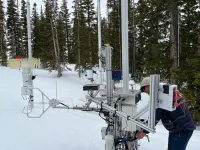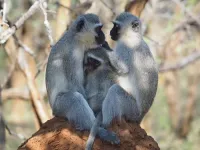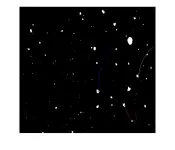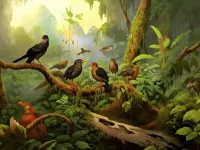(Press-News.org) Recently, a research team led by Prof. Sun Zhong at Peking University reported an analog hardware solution for real-time compressed sensing recovery, which has been published as an article titled "In-memory analog solution of compressed sensing recovery in one step" in Science Advances. In this work, a design based on a resistive memory (also known as memristor) array for performing instantaneous matrix-matrix-vector multiplication (MMVM) is first introduced. Based on this module, then an analog matrix computing circuit that solves compressed sensing (CS) recovery in one step (within few microseconds) is disclosed.
CS has been the cornerstone of modern signal and image processing, across many important fields such as medical imaging, wireless communications, object tracking, and single-pixel cameras. In CS, sparse signals can be highly undersampled in the front-end sensor, which breaks through the Nyquist rate and thus significantly improving sampling efficiency. In the back-end processor, the original signals can be faithfully reconstructed by solving a sparse approximation problem. However, the CS recovery algorithm is usually very complicated and involves high-complexity matrix-matrix operations and pointwise nonlinear functions. As a result, CS recovery in the back-end processor has become the accepted bottleneck in the CS pipeline, which prevents its application in high-speed, real-time signal processing scenarios.
To speed up the CS recovery computation, there have been two lines of efforts in the traditional digital domain, using either advanced algorithms (e.g., deep learning), or parallel processors (e.g., GPU, FPGA and ASIC). However, the computing efficiency is fundamentally limited by the polynomial complexity of matrix operations in digital processors. To this end, analog computing has been regarded as an efficient approach for accelerating CS recovery, thanks to its inherent computational parallelism. Nevertheless, again, due to the high complexity of CS recovery algorithms, previous analog computing solutions either rely on pre-calculated matrix-matrix multiplication which is of a cubic complexity, or bare the discrete iterative process that requires expensive while frequent analog-digital conversions. Therefore, solving CS recovery in one step remains a grand challenge.
In order to solve this problem, the team from Peking University first designed an analog in-memory computing module that implements MMVM in one step, thus avoiding the pre-calculation of matrix-matrix multiplication. By connecting this MMVM module with other analog components to form a feedback loop, the resulting circuit maps accurately the local competitive algorithm (LCA), which solves CS recovery in one step without discrete iterations. To validate the circuit, the team fabricated a resistive memory array with a standard semiconductor process, based on which the LCA circuit was constructed on a PCB for performing CS recovery. The compressed data was converted as input voltage signals in the circuit, and the recovered signals were acquired in a continuous-time manner. With this circuit, recovery of 1D sparse signals, 2D natural RGB images and magnetic resonance images (MRI) have been demonstrated in experiments. The normalized mean square error (NMSE) is around 0.01, and the peak signal-to-noise ratio (PSNR) of the images is 27 dB. The speed of this circuit is estimated to be 1-2 orders of magnitude faster than traditional digital approaches such as deep learning, and is also better than other electronic or photonic analog computing solutions. The circuit is highly promising to be implemented in the back-end CS processor to deliver real-time processing capability in the microsecond regime, which might in turn enable advanced medical, visual and communication techniques.
Source: School of Electronics Engineering and Computer Science
END
Pushing compressed sensing to real-time edge applications
2023-12-19
ELSE PRESS RELEASES FROM THIS DATE:
The science behind snowflakes
2023-12-19
Tim Garrett has devoted his scientific career to characterizing snowflakes, the protean particles of ice that form in clouds and dramatically change as they fall to Earth.
Now the University of Utah atmospheric scientist is unlocking the mystery of how snowflakes move in response to air turbulence that accompanies snowfall using novel instrumentation developed on campus. And after analyzing more than half a million snowflakes, what his team has discovered has left him astonished.
Rather than something incomprehensibly complicated, predicting how snowflakes move proved to be surprisingly ...
COVID-19 infection causes teen’s vocal cord paralysis in first-of-its-kind case
2023-12-19
Physician-researchers from Mass Eye and Ear, a member of Mass General Brigham, report the first pediatric case of bilateral vocal cord paralysis after COVID-19 (SARS-CoV-2) infection. The patient, an otherwise healthy 15-year-old female, came to the emergency department at Massachusetts General Hospital with symptoms of respiratory distress nine days after diagnosis with SARS-CoV-2 infection. Examination with an endoscope revealed bilateral vocal cord paralysis, which is an immobility of both vocal cords found in the larynx or voice box. The researchers concluded that this paralysis was likely a downstream ...
Vervet monkeys follow different social “norms” and respond to “peer pressure,” new long-term study shows
2023-12-19
People living in different communities follow different social customs or norms. In some places, for instance, it might be standard practice to greet each person you see on the street, while in others that simply isn’t done. In some cases, such differences may even vary from one neighborhood to the next. Now researchers reporting in the journal iScience on December 19 have found similarly varied social traditions and styles among neighboring groups of vervet monkeys.
“We report the existence of behavioral traditions of social customs in vervet ...
Would you like to groom me?
2023-12-19
Researchers at UNIL’s Department of Ecology and Evolution reveal the existence of social traditions in vervet monkeys. This work was published in iScience on December 19, 2023.
British tits have learned from each other how to pierce the lids of milk bottles left on doorsteps. On the island of Koshima, Japanese macaques started washing sweet potatoes to rid them of sand. The animal realm is full of examples of traditions linked to food, tool use or hunting techniques that have spread within specific communities. However, few traditions of social nature, i.e. how individuals interact with each other, have been described.
A ...
Snowflakes swirling in turbulent air as they fall through a laser light sheet. Credit: Singh et al.
2023-12-19
WASHINGTON, Dec. 19, 2023 – A winter wonderland calls to mind piles of fluffy, glistening snow. But to reach the ground, snowflakes are swept into the turbulent atmosphere, swirling through the air instead of plummeting directly to the ground.
The path of precipitation is complex but important to more than just skiers assessing the potential powder on their alpine vacation or school children hoping for a snow day. Determining snowflake fall speed is crucial for predicting weather patterns and measuring climate ...
Clinicians could be fooled by biased AI, despite explanations
2023-12-19
AI models in health care are a double-edged sword, with models improving diagnostic decisions for some demographics, but worsening decisions for others when the model has absorbed biased medical data.
Given the very real life and death risks of clinical decision-making, researchers and policymakers are taking steps to ensure AI models are safe, secure and trustworthy—and that their use will lead to improved outcomes.
The U.S. Food and Drug Administration has oversight of software powered by AI and machine learning used in health care and has issued guidance for developers. This includes a call to ensure the ...
Measuring the impact of AI in the diagnosis of hospitalized patients
2023-12-19
About The Study: Although standard artificial intelligence (AI) models improve diagnostic accuracy, systematically biased AI models reduced diagnostic accuracy, and commonly used image-based AI model explanations did not mitigate this harmful effect in this multicenter randomized clinical vignette survey study involving hospitalist physicians, nurse practitioners, and physician assistants from 13 states.
Authors: Michael W. Sjoding, M.D., of the University of Michigan Medical School, and Jenna Wiens, Ph.D., of the University of Michigan, Ann Arbor, are the corresponding authors.
To ...
Disparities in preoperative goals of care documentation in veterans
2023-12-19
About The Study: In this study of 13,000 patients, few patients undergoing surgical procedures completed preoperative life-sustaining treatment documentation, with disparities in documentation rates based on race, ethnicity, rurality of patient residence, history of mental health disability, and access to high-volume facilities within a Veterans Affairs cohort.
Authors: Adela Wu, M.D., of the U.S. Department of Veterans Affairs, in Palo Alto, California is the corresponding author.
To access the embargoed study: Visit our For The Media website at this link https://media.jamanetwork.com/
(doi: ...
Screening for social determinants of health during primary care and emergency department encounters
2023-12-19
About The Study: This study found that patients screened in the emergency department (ED) were more likely to screen positive for Social Determinants of Health (SDOH) needs, which is not surprising given utilization patterns. Patients with SDOH needs have limited health care access and are more likely to use the ED than primary care. Although primary care–based screening found lower SDOH needs relative to the ED, primary care may be better optimized to follow and ultimately address SDOH needs.
Authors: Stacie ...
Study uncovers major hidden human-driven bird extinctions
2023-12-19
Humans have wiped out around 1,400 bird species – twice as many as previously thought – with major implications for the ongoing biodiversity crisis, a new study has found.
Many of the world’s islands were previously untouched paradises, but the arrival of people to places like Hawaii, Tonga and the Azores led, over time, to far-reaching impacts including deforestation, overhunting and the introduction of invasive species. Consequently, bird species were wiped out.
While the demise of many birds since the 1500s has been recorded, our knowledge of the fate of species before this relies on fossils, ...



